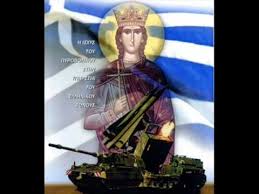Saint Barbara was the extremely beautiful daughter of a wealthy Greek heathen named Dioscurus, who lived near Nicomedia in Asia Minor.
Because of her singular beauty and fearful that she be demanded in marriage and taken away from him, he jealously shut her up in a tower to protect her from the outside world.
Shortly
before embarking on a journey, he commissioned a sumptuous bathhouse to
be built for her, approving the design before he departed. Barbara had
heard of the teachings of Christ, and while her father was gone spent
much time in contemplation. From the windows of her tower she looked out
upon the surrounding countryside and marveled at the growing things;
the trees, the animals and the people. She decided that all these must
be part of a master plan, and that the idols of wood and stone
worshipped by her parents must be condemned as false. Gradually she came
to accept the Christian faith.
As
her belief became firm, she directed that the builders redesign the
bathhouse her father had planned, adding another window so that the
three windows might symbolize the Holy Trinity.
When
her father returned, he was enraged at the changes and infuriated when
Barbara acknowledged that she was a Christian. He dragged her before the
perfect of the province, who decreed that she be tortured and put to
death by beheading. Dioscurus himself carried out the death sentence. On
his way home he was struck by lightening and his body consumed.
Saint
Barbara lived and died about the year 300 A.D. She was venerated as
early as the seventh century. The legend of the lightning bolt which
struck down her persecutor caused her to be regarded as the patron saint
in time of danger from thunderstorms, fires and sudden death.
When
gunpowder made its appearance in the Western world, Saint Barbara was
invoked for aid against accidents resulting from explosions--since some
of the earlier artillery pieces often blew up instead of firing their
projectile, Saint Barbara became the patroness of the artillerymen.
Saint
Barbara is usually represented standing by a tower with three windows,
carrying the palm of a martyr in her hand. Often, too, she holds a
chalice and a sacramental wafer and sometimes cannon are displayed near
her. The feast of Saint Barbara falls on December 4th and is
traditionally recognized by a formal Dining-In or military dinner, often
involving the presentation of the Order of Saint Barbara.
Saint
Barbara became the patron saint of artillerymen. She is also
traditionally the patron of armourers, militaty engineers, gunsmiths,
miners and anyone else who worked with cannon and explosives. She is
invoked against thunder and lightning and all accidents arising from
explosions of gunpowder. She is venerated by everyone who faces the
danger of sudden and violent death in work. The magazine of a fort or
warship is called santa bárbara in Spanish language.

- St. Barbara's Day, 4 December, may be celebrated by Hellenic (Greek) Artillery, artillery formations, units and sub-units with church parades, sports days, guest nights, cocktail parties, open house, and other activities.
- The Order of Saint Barbara is a military honor society of the US for both the US Army and the US Marine Corps Artillery, including field artillery and Air Defense Artillery.
- Also, British (Royal Artillery) and Canadian (Royal Canadian Artillery) celebrate St. Barbara's Day, 4 December.
- In Italy and in many Roman Catholic regions, the celebration begins on the first of December and continues for a week, but the big day is December 4, St. Barbara's formerly designated day (she was one of the saints removed from the Catholic Calendar by the Vatican in 1969 because of doubts about her existence and tale).
Because of her identification with lightning and cannonry, in Santería she is identified with the god Shango, god of lightning and war.






No comments:
Post a Comment